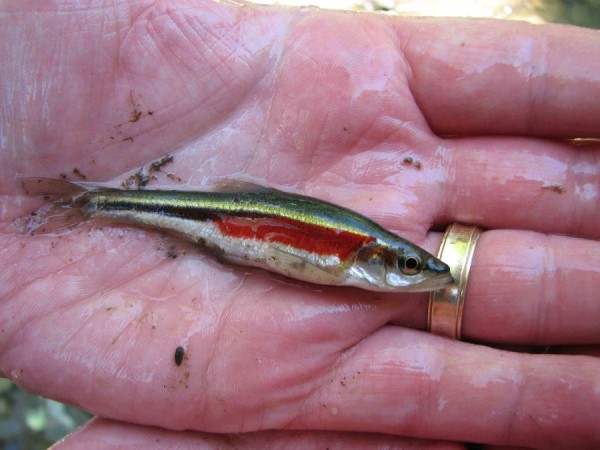 The redside dace gets its name from the colour it turns during spawning season.
The redside dace gets its name from the colour it turns during spawning season.
A species of small but mighty fish are the latest residents of Trevor Pitcher’s research centre — pioneers in the quest to bring endangered fish back from the brink of extinction.
The redside dace is a species of minnow that is one of Canada’s most endangered freshwater species. It not only controls populations of flying insects, it’s a piscine version of a canary in a coal mine, a bioindicator of an ecosystem’s health.
Once the streams they call home get turbid or too warm, redside dace die off. Populations are diminishing so quickly, it is estimated that only a few hundred individuals are left in Canada. Without intervention, the species could be extinct within five to 10 years.
Enter Dr. Pitcher, director of UWindsor’s Freshwater Restoration Ecology Centre on the Detroit River in LaSalle. Pitcher, who has an extensive captive breeding program for game fish, hopes to create sufficient populations of redside dace to reintroduce into their natural environments.
Pitcher recently collected about 100 redside dace from Ohio where they are more plentiful and, with the necessary federal permits, brought them to his research centre. In Canada, they are found in streams in the Greater Toronto Area, but Pitcher explained he didn’t want to take any specimens there so as not to further diminish their shrinking numbers.
With the help of his team of two master’s students and a post-doctoral fellow, he hopes to create sufficient populations of redside dace to restore them to self-sustaining population levels in the GTA in the next five to seven years.
“We’ve gotten to the breaking point,” Pitcher said. “We are racing against the clock here.”
Pitcher said the redside dace is an example of how scientists have been good at monitoring the decline of species. “What we’re not so good at is doing something about it, actually reversing that decline.”
The federal Department of Fisheries and Oceans has acknowledged that with a $1.2 million grant over the next three years to establish the Canadian Freshwater Species at Risk Network. Pitcher’s work on the redside dace is funded through that grant.
The species gets its name from the bright red colour it turns during spawning season. Unlike sturgeons, which doesn’t reach sexual maturity for 20 years, the redside dace is ready to reproduce after just two years. It grows to a length of less than eight centimetres but possesses the remarkable ability to propel itself half a metre out of the water to pluck insects off branches and out of the air.
Pitcher calls the redside dace “a poster child for the negative effects of urbanization on biodiversity.” Salt used on roadways in winter ends up in the streams they call home. Other pollution, too, contributes to the turbidity of the water where they live, making it difficult for them to see their prey. They have limited thermal tolerance, so they die off as water temperature rises, Pitcher said.
“We’re doing a good job at rehabilitating the habitats, but the populations have been knocked down so much they just can’t rebound on their own.”
This spring, the research centre will be adding two more buildings — one dedicated for artificial streams 10 ½ metres long, 1.2 metres wide and 1.2 metres deep for the redside dace.
The 1,000-litre tank where the redside dace currently reside will become a nursery of sorts where the hatchlings can be raised in filtered water kept at 10° C, free from contaminants and harmful organisms.
Pitcher’s hatchlings will have to be “trained” to think like they were raised in the wild. He will introduce them to “predators” — simulated versions of larger fish that normally prey on minnows — and “smelly water.”
“We’re trying to infuse Mother Nature into this captive breeding program to improve the survival prospects of fish we eventually release back into the wild” Pitcher said.
Pitcher’s team will track the populations of redside dace over time through the use of environmental DNA, commonly referred to as eDNA. Pitcher will team up with fellow scientists Chris Wilson and Daniel Heath, who has refined the science so that all the organisms living in a given ecosystem can be identified by drawing a water sample of just a few litres.
The research will be featured at the Toronto Zoo where there will be an UWindsor exhibit on the redside dace. It’s a fitting partnership, Pitcher said, since the zoo is located in the species’ natural range in the Greater Toronto Area. The exhibit will be a way of “engaging the public in the restoration efforts for the redside dace and also for freshwater species at risk in general,” he said.
Pitcher said if his research is successful, the redside dace could be a model of how to reintroduce endangered species to the wild.
“This is a test case for decades to come.”
—Sarah Sacheli
